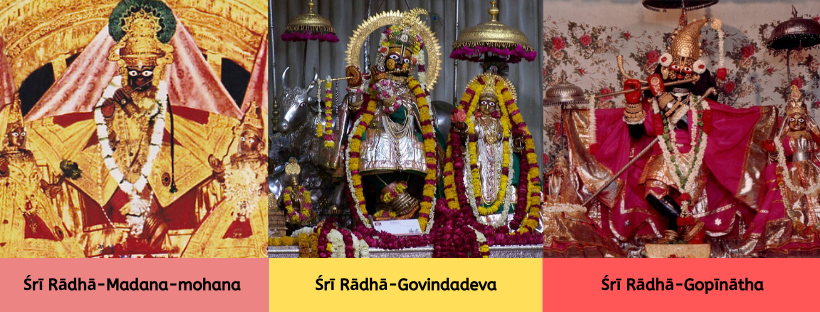
After the departure of Lord Krishna, all the Pandavas, unable to bear the separation from Krishna, decided to leave this world. Before they left, Maharaj Yuddhisthir appointed Parikshit, son of Abhimanyu, as the emperor of the whole world. Vajranabha, the great-grandson of Lord Krishna, son of Aniruddha, was made the king of Mathura.
Vajranabha missed Krishna very much. Many great personalities requested him to reestablish the glories of Vrindavan. Vrajanabha decided to excavate all those places in Vraja where Lord Krishna performed His pastimes. He sat under a tree on the banks of Yamuna and prayed to Krishna to reveal His divine pastimes places in Vraja. He received Krishna’s mercy, who revealed His Vrindavan pastimes in his heart. Vajranabha then called upon Vishwakarma, the architect of the demigods to install various Deities. The three principal Deities carved by him were Radha Madanmohana, Radha Govindadev and Radha Gopinath.
At that time there was no one other than Uttara, mother of Maharaj Parikshit, who had seen Krishna directly. The first Deity she saw was of Madanmohan. When Vajranabha showed this Deity to Uttara she said Madanmohan’s feet perfectly resemble Krishna’s feet. Next, when she saw the beautiful form of Govindadeva, she explained that the chest of Krishna was exactly like Him. Finally, when she saw the Deity of Gopinath, she explained that the beautiful smiling face of Gopinath exactly resembled Krishna’s face.
One can understand the importance of these three Deities of Vrindavan for the devotees. Krishnadas Kaviraj Gosvami declares that these three Deities of Vrindavan are the very life and soul of all Gaudiya Vaisnavas.
śrī-rādhā-saha ‘śrī-madana-mohana’
śrī-rādhā-saha ‘śrī-govinda’-caraṇa
śrī-rādhā-saha śrīla ‘śrī-gopīnātha’
ei tina ṭhākura haya ‘gauḍiyāra nātha’
The Vṛndāvana Deities of Madana-mohana with Śrīmatī Rādhārāṇī, Govinda with Śrīmatī Rādhārāṇī, and Gopīnātha with Śrīmatī Rādhārāṇī are the life and soul of the Gauḍīya Vaiṣṇavas.
ei tina ṭhākura gauḍīyāke kariyāchena ātmasāt
e tinera caraṇa vandoṅ, tine mora nātha
These three Deities of Vrindavan [Madana-mohana, Govinda and Gopīnātha] have absorbed the heart and soul of the Gauḍīya Vaiṣṇavas [followers of Lord Caitanya]. I worship Their lotus feet, for They are the Lords of my heart.
Srila Prabhupada explains the role these three special Deities of Vrindavan play in the lives of devotees in his purport of the above verse –
The author of Śrī Caitanya-caritāmṛta offers his respectful obeisances unto the three Deities of Vrindavan named Śrī Rādhā-Madana-mohana, Śrī Rādhā-Govindadeva and Śrī Rādhā-Gopīnāthajī. These three Deities are the life and soul of the Bengali Vaiṣṇavas, or Gauḍīya Vaiṣṇavas, who have a natural aptitude for residing in Vṛndāvana. The Gauḍīya Vaiṣṇavas who follow strictly in the line of Śrī Caitanya Mahāprabhu worship the Divinity by chanting transcendental sounds meant to develop a sense of one’s transcendental relationship with the Supreme Lord, a reciprocation of mellows (rasas) of mutual affection, and, ultimately, the achievement of the desired success in loving service. These three Deities are worshiped in three different stages of one’s development. The followers of Śrī Caitanya Mahāprabhu scrupulously follow these principles of approach.
Gauḍīya Vaiṣṇavas perceive the ultimate objective in Vedic hymns composed of eighteen transcendental letters that adore Kṛṣṇa as Madana-mohana, Govinda and Gopījana-vallabha. Madana-mohana is He who charms Cupid, the god of love, Govinda is He who pleases the senses and the cows, and Gopījana-vallabha is the transcendental lover of the gopīs. Kṛṣṇa Himself is called Madana-mohana, Govinda, Gopījana-vallabha and countless other names as He plays in His different pastimes with His devotees.
According to the Vedic principles, there are three stages of spiritual advancement, namely, sambandha–jñāna, abhidheya and prayojana. Sambandha-jñāna refers to establishing one’s original relationship with the Supreme Personality of Godhead, abhidheya refers to acting according to that constitutional relationship, and prayojana is the ultimate goal of life, which is to develop love of Godhead
So these three Deities of Vrindavan, each one of Them represent
- Sri Radha Madanmohan are the presiding Deity of Sambanda – our eternal relationship with Krishna, we are His part and parcel.
- Sri Radha Govindadev are the presiding Deity of Abhidheya – how to act in that relationship. devotional service.
- Sri Radha Gopinatha are the presiding Deity of Prayojana– ultimate goal, love of Godhead.
Krishna willing, in our upcoming blogs, we will read in a little more detail about these special Deities of Vrindavan and try to understand and appreciate the unique role They play in the lives of all the Gaudiya Vaisnavas.
All glories to the three main Deities of Vrindavan.
All glories to Srila Prabhupada.
Your servant,
Giriranj dasa
P.S.: It is said that if one gets darshan of these three Deities of Vrindavan on the same day, especially on an Ekadasi, then it is accepted that one has taken full darshan of Krishna. I have posted Their pictures and today is Ekadasi.

